-
Who attends a 3-day class at Autogeek at $1,495.00?
Who attends a 3-day class at Autogeek at $1,495.00?
You know, I'd say most people think the people that attend our classes are detailers. But that's not true. Sure it's natural to think that but 60% of the people that attend ANY of our classes are simply people that love to detail their own cars (or boats), and want to get real-world, hands-on training before they invest hundreds of dollars, (sometimes thousands of dollars), into
- Tools
- Pads
- Products
- Towels
- Equipment (steam machines and hot water extractors
- Supplies
Let me share a real-world example that may surprise you and may also convince you that any of our classes are THE best option on the market today.
Meet Louise
This is Louise. She flew from California to Stuart, Florida simply to learn how to work on her daily driver, a 2014 Mustang Convertible. She is a Psychiatrists with her own practice and is a Professor at a College. She is NOT a detailer. She was like most the people that attend our classes, passionate about making cars shine!
The below pictures were taken at one of our September 2017 3-day classes here at Autogeek. We hold these completely hands-on 3-day classes three times a year here at Autogeek. The schedule is ALWAYS the same BECAUE we know people often time save up their money and schedule their lives around making the trip to Florida to take this class. I'd say off hand that 50% of the people that take this class come from other states or other countries. The primary reason why they travel so far to attend this class is due to the QUANTITY of high caliber cars they get to train on, (not demo hoods), and to the overwhelming quantity of tools, pads and products they get to train with.
The class detailed 13 cars in 3-days! The ONLY way this can be done is if they are on their feet working, not sitting in a chair listening to someone drone on and on and on....
Let me share the story behind the pictures below for just ONE of the cars this class detailed. This happens to be one of the cars I used to teach the RUPES paint polishing system. Each type and brand of tool gets it's own set of 2 and sometimes 3 cars for the class to train on. The other car you see behind us that the class trained with the RUPES paint polishing system is a REAL (not a tribute car), it's a real 1970 AAR Cuda.
Now the story....
As we work through cars, I walk around and watch people. I study their technique. If they are doing everything right I let them know. If I see areas where I can tweak their technique to improve they style, I politely stop them and show them different ways to accomplish the procedure they are currently practicing.
For Louise, in this first picture I find Louise buffing on an edge right next to a raised body line. So I stop her and explain whey it's not a good practice to buff on an edge or a raised body line, (the paint will tend to be thinner on these areas and if you're not careful you could buff through the paint).

I share that RUPES is NOT a tool - it's a SYSTEM. You match the pad size and the tool to the size of the panel to be buffed.
So for the large flat sections of a car you can use the BigFoot 21. The 7" diameter pad makes quick work of removing swirls, scratches, water spots and oxidation from the larger flat panels of cars, trucks, SUVs and even things like expensive clearcoated RVs.

I also shared how it's important to hold the tool in such a way as to maintain the flat surface of the pad flat to the panel.

The Ghosting Footprint
In the picture below, I'm explaining the term I coined called the ghosting footprint. This is a characteristic of long-stroke orbital polishers. Here's my article on this topic.
The ghosting footprint and the actual footprint - Long Stroke Free Spinning Orbital Polishers
I don't explain what the ghosting footprint is when it comes to long stroke orbital polishers, I also explain why it's important to understand this characteristic when it comes to removing swirls next to and edge or raised body line. And this is where smaller tools come into play in order to remove swirls and scratches next to edges or raised body lines. Or... using a different technique....
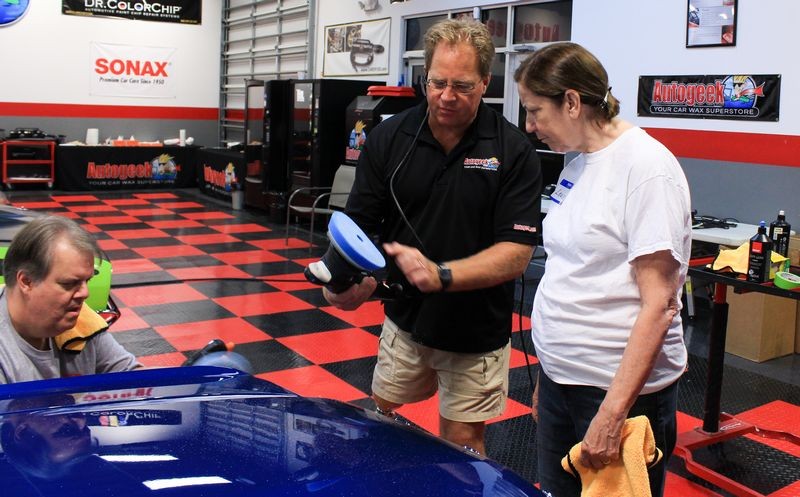
Switch tools, switch pads --> get small.
After learning how to use the BigFoot 21, next I shared with her how to knock out the sections of paint along the edge of the hood and fender and also next to the raised body line.
How?
For doing edgework Louise switched over to the RUPES Nano Long Neck in rotary mode with a 1" RUPES blue coarse foam pad. This made it easy to work next to the edge and the raised body line without the fear or risk of buffing through the clearcoat.
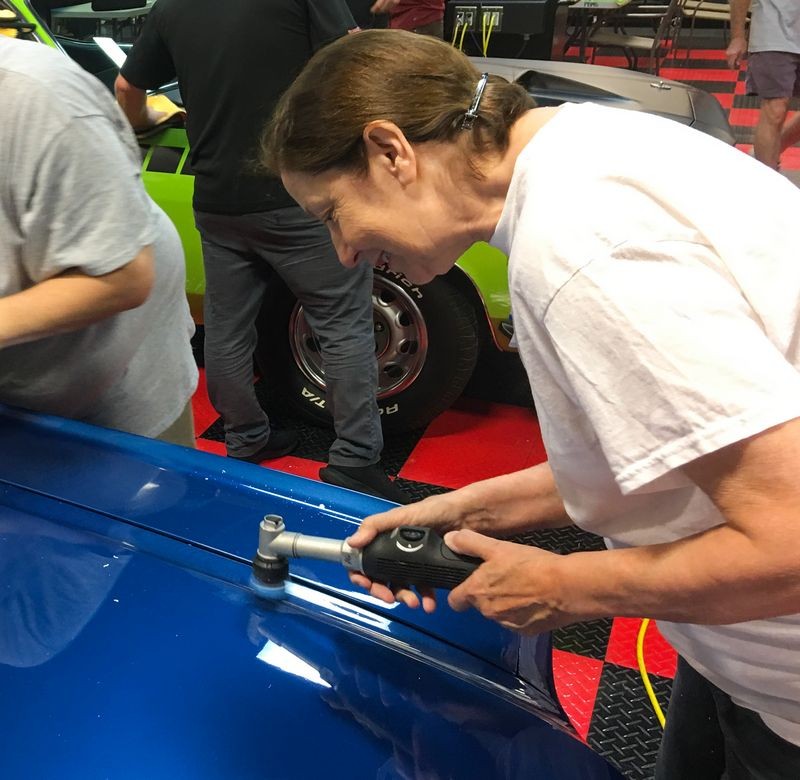

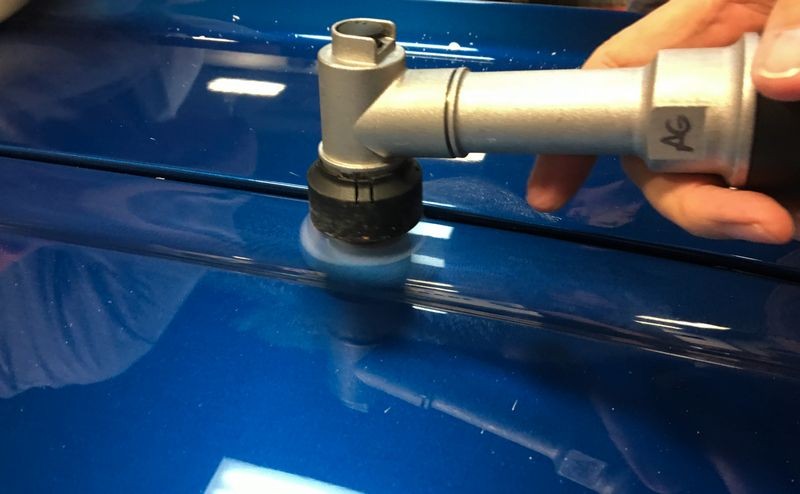
How to turn a 7" pad into a 1" pad
On page 64 of my RUPES how-to book, I share how you can go up on edge with the RUPES BigFoot 21 and a 7" pad and the isolated pressure to only a small section of the edge of the paint will cause the pad to REVERSE ROTATE but --> maintain pad rotation, as in NOT stall out.
Once you understand this unique characteristic to this free spinning long stroke orbital polisher you discover this enables you to buff the paint along an edge or buff out a thin section of paint between a raised body line and an edge.
This technique is NOT for the timid. This technique is not something you want to learn on another person's toy or expensive car. I discovered this unique characteristic while buffing out the 1998 Ferrari 355 F1 Spyder shown on the cover of the RUPES book and discussed in the book back when I detailed this Ferrari for this project back in in 2014.
NOTE: It is vitally important that if you choose to use this technique that the Velcro on the backing plate and on the back of the buffing pad is NOT worn out. If the velcro is worn out, it's possible that when you go up on edge and put increased pressure to a small portion of and edge of the face of the pad that the force can cause the attachment between the two velcro surfaces to let go and the pad can fly off. It's happened to me and after it happened one time I always test the attachment strength of the two velcro surfaces before attempting this technique.
Going up on edge with a RUPES BigFoot 21

Not the hand positions to hold the tool
If you have a copy of my RUPES book you've seen and read about hand positions. Sometime, the last thing you want to do is hold the hand grip at the head of the tool as it block your view of what the pad is doing and where the pad is touching.

Focused attention....
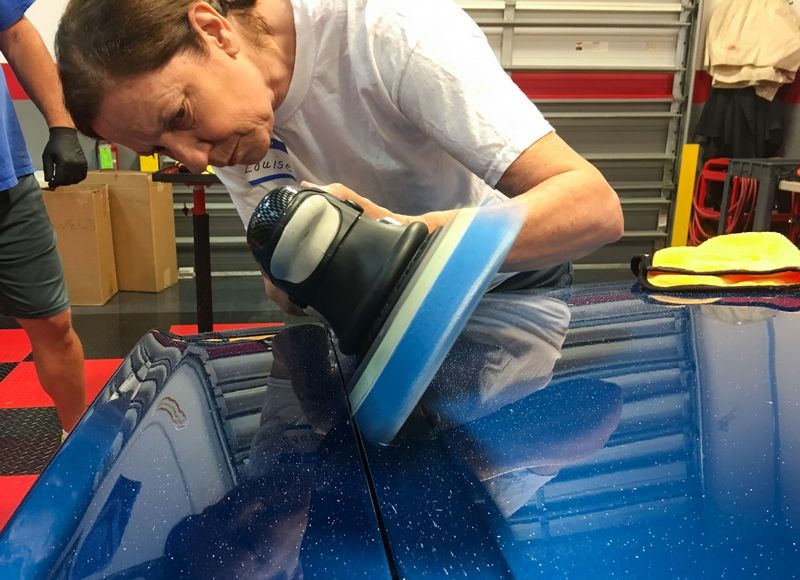
Eyes on the target...
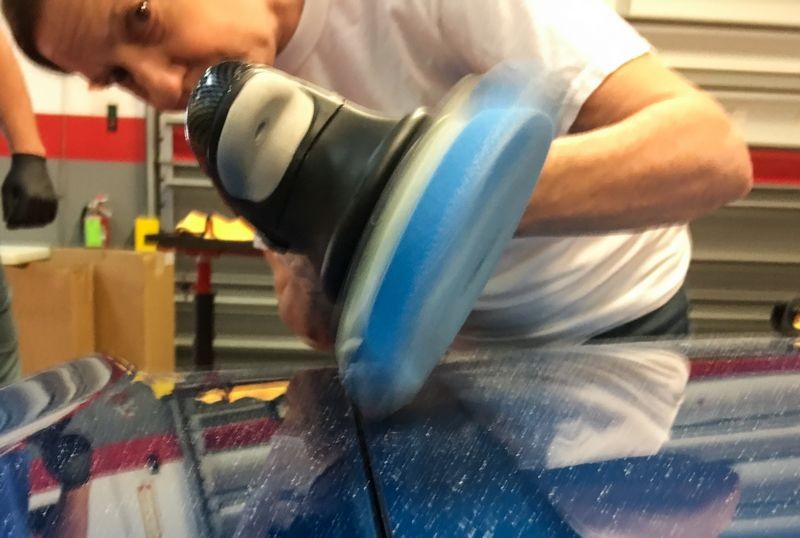
If she can do it.... anyone can do it.
And while you can read this article and look at the pictures, when you come to one of our classes.... I'll show you in person,
How to make any polisher dance on paint.
See all the pictures from this class here,
Pictures & Comments from the September 2017 Competition Ready Detailing Class

-
Post Thanks / Like - 1 Thanks, 2 Likes, 0 Dislikes
 Diner
Diner thanked for this post













 Thanks:
Thanks:  Likes:
Likes:  Dislikes:
Dislikes: 


 Reply With Quote
Reply With Quote
Bookmarks